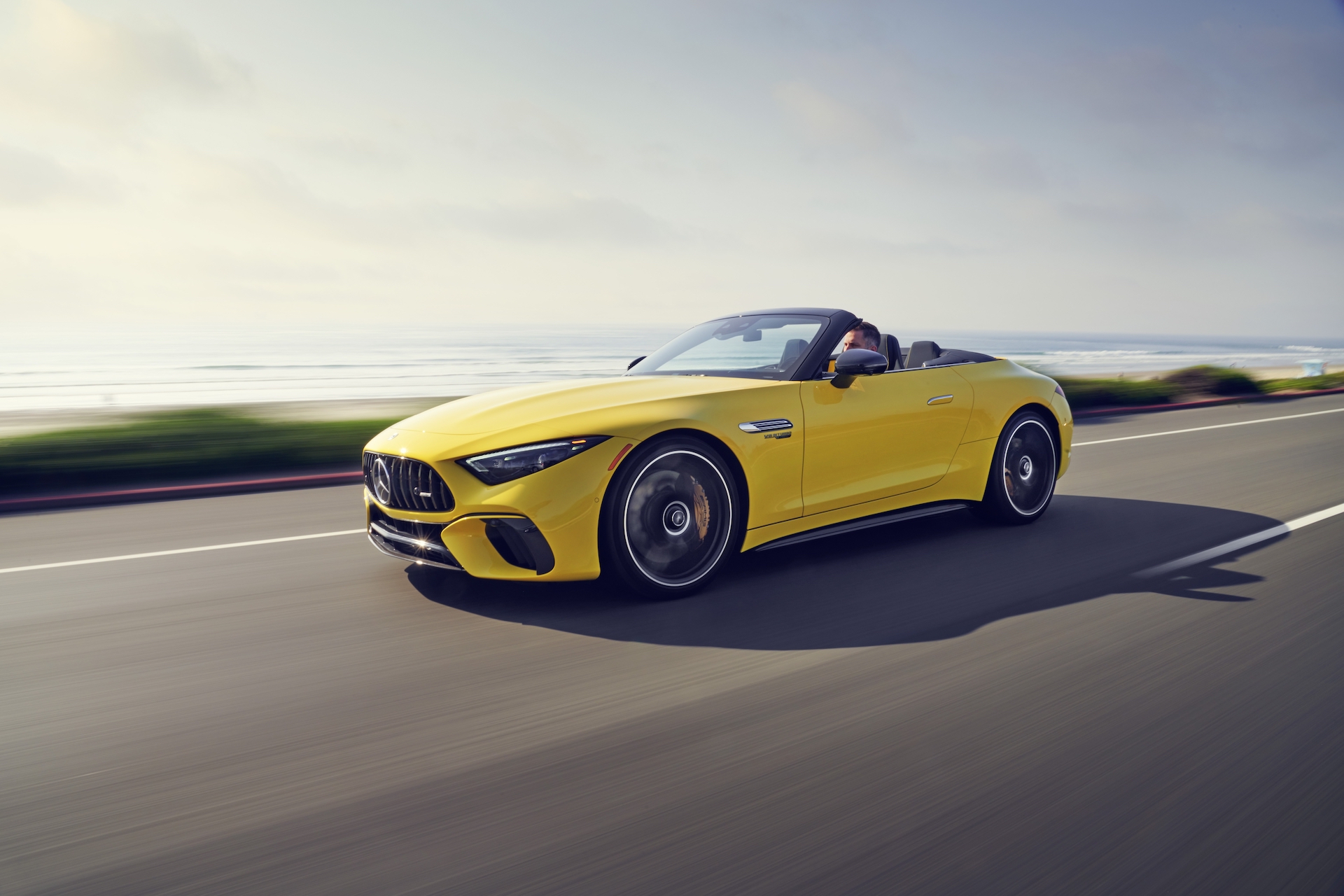The pea soup fog and steady rain in the mountains outside of Palms Springs, California, are making it hard to figure out the character of the 2022 Mercedes-Benz AMG SL. With its new 2+2 layout, is the SL now a Porsche 911 competitor? Is it the lovechild of a C-Class cabriolet and an AMG GT roadster? Or do its soft top and small rear seat simply revive the third-generation SL model last sold in 1989?
The 2022 SL marks a complete redesign of a beloved sports car that traces its roots back to 1952. It rides on a new aluminum-intensive platform that could very well be the last one Mercedes develops for the internal combustion engine. It also marks three important changes from the last-generation model: that rear seat and cloth top, and standard all-wheel-drive.
The new SL is also the first engineered from start to finish by Mercedes’ AMG performance arm. Those roots give it a performance credibility it hasn’t had since the first-generation 300SL that was derived from a race car.
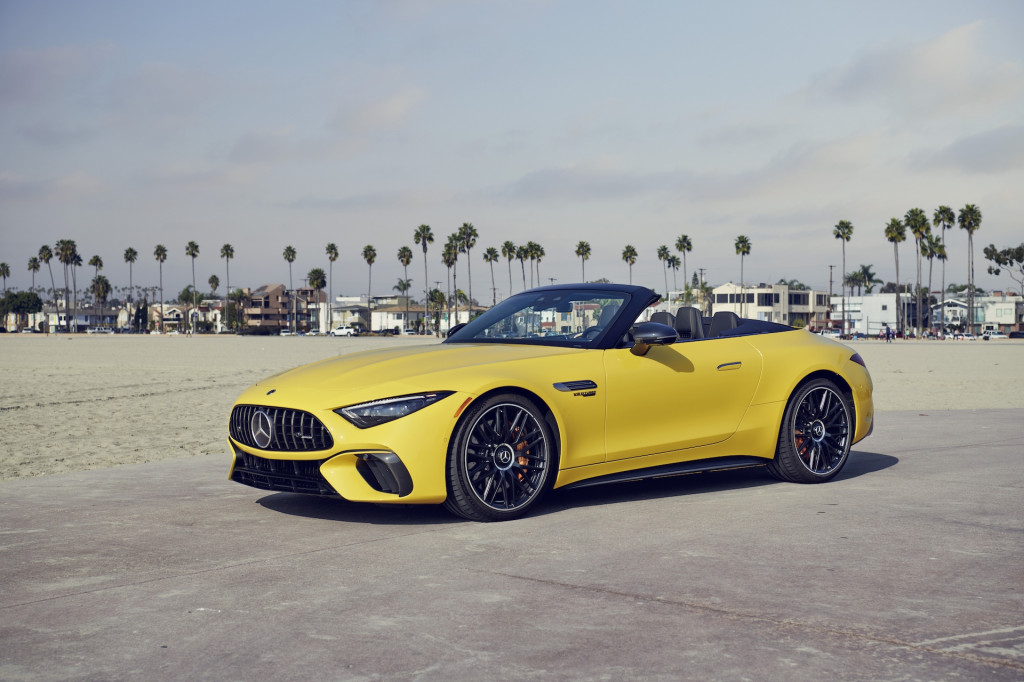
2022 Mercedes-Benz SL 63 AMG
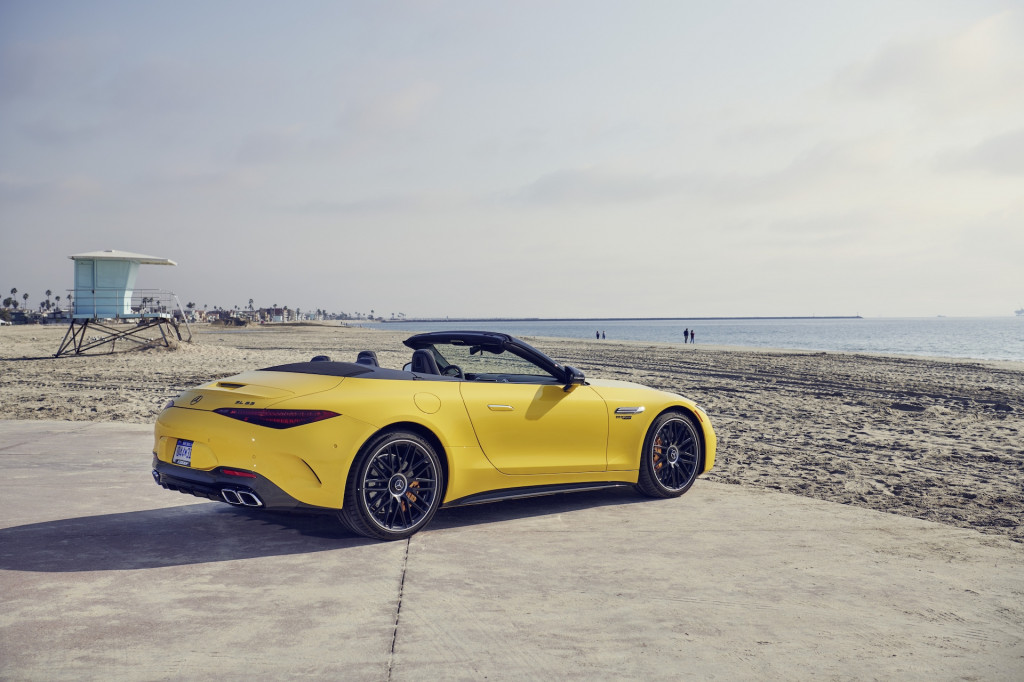
2022 Mercedes-Benz SL 63 AMG
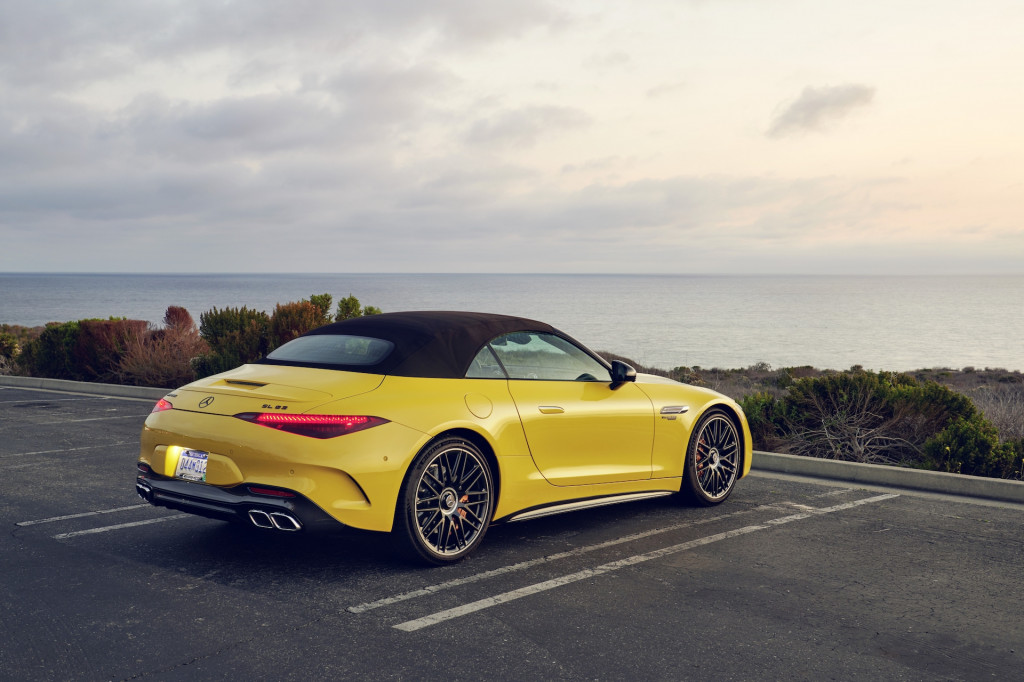
2022 Mercedes-Benz SL 63 AMG
The AMG crew also gave the SL a host of standard and optional performance goodies. It starts under the long, low hood, where the M177 twin-turbo 4.0-liter comes in two states of tune: powerful and rambunctious. In the SL 55, the V-8 huffs down 16.0 psi of boost, while the SL 63 line-topper inhales 22.5 psi. Both engines deliver the performance mail, and both are modified for use in the SL with a new oil pan, new intake and exhaust ducts, and repositioned intercoolers.
The SL sends its power to the optional 275/35R21 front and wider 305/30R21 Michelin Pilot Sport 4S tires (245/40 and 295/35 tires on 20-inch wheels are standard) via a 9-speed wet-clutch dual-clutch automatic to launch the car from 0-60 mph in 3.9 seconds. The SL 63 uses the same driveline hardware to slay the 0-60 mph run in 3.4 seconds.
Familiar to Mercedes fans, the 4.0-liter V-8 is real and it’s spectacular, while the 9-speed is real and pretty damn good. When either version is pushed, the V-8 pauses ever so slightly to inhale, then sounds a deep, throaty growl as the SL explodes forward. Let off in the Sport, Sport+, or Track modes, and NASCAR-style pops and crackles induce giggles. (I can’t help it. I’m 13 at heart.) The power stays on boil, too, pushing the SL 63 all the way to 196 mph, which is a sure way to give yourself racing hair with the top down. The SL 55 tops out at a mere 183 mph—barely even ticket-worthy.
I’m not about to induce any forward-thrust explosions with fog so thick I can barely see the taillights of the SL a few car lengths in front of me. With steep drop-offs unprotected by guardrails on these mountain roads, I’m also not keen on finding the limits of grip for the chunky Michelin tires. If only Mercedes AMG could control the weather like they do a suspension.

2022 Mercedes-Benz AMG SL body shell
Too bad Mercedes can’t, because on 350 other days of the year this would be a great opportunity to test the stiff new structure and some pretty cool advanced suspension technology. Referred to as the MSA (Modular Sports Architecture), the SL’s exclusive platform features space-frame construction relying on a mix of aluminum, magnesium, steel, and fiber composites to make the body shell stiff and light. Despite a wheelbase that is 4.6 longer due to the added rear seat, the new structure has 18% more structural rigidity than the outgoing model, and 50% more bending rigidity versus the fantastic AMG GT roadster.
Lightweight coil springs and adaptive dampers come standard, but rather than air springs or even active anti-roll bars to fight body lean, the SL 63 uses a hydraulic suspension that’s linked at all four corners. Like the system in the McLaren 720S, this advanced setup pulls the inside tire up when the outside tire is compressed through the flow of hydraulic fluid to keep the body level. It works quickly and effectively, giving the SL the flat cornering of a sports car. AMG engineers chose it for that purpose and to save weight versus those other systems.
Mercedes compensates for the SL’s additional length by making rear-axle steering standard. It can turn the rear wheels counter to the fronts up to 2.5 degrees to virtually lengthen the wheelbase in sharp corners and parking lot situations.
Even in these adverse conditions, some of the SL’s dynamic strengths show through. The 12.8:1 steering ratio makes it quick, and it feels weighty and direct through the chunky, small-diameter steering wheel. That quick turn-in is met by flat cornering and incredible body control enabled by the hydraulic dampers and double-wishbone front and rear suspensions that all conspire to maintain a large contact patch in corners. The rear end follows along quickly, with reactions made sharper by the rear-axle steering that steers opposite of the fronts not up to 37 mph like in many cars, but up to 62 mph, where it can be more useful for track driving.
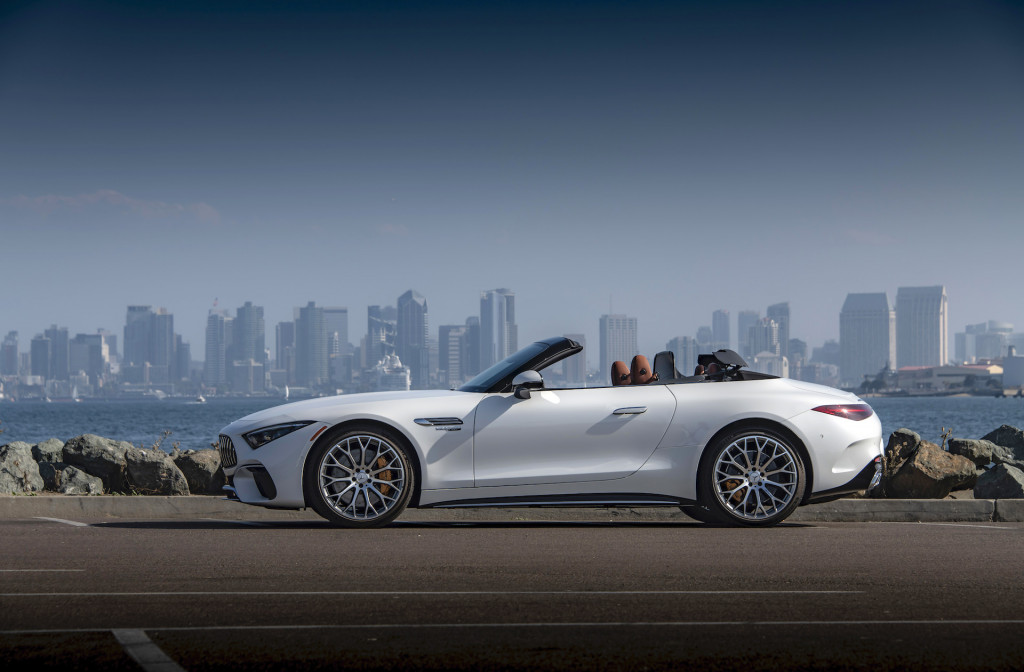
2022 Mercedes-Benz SL 55 AMG
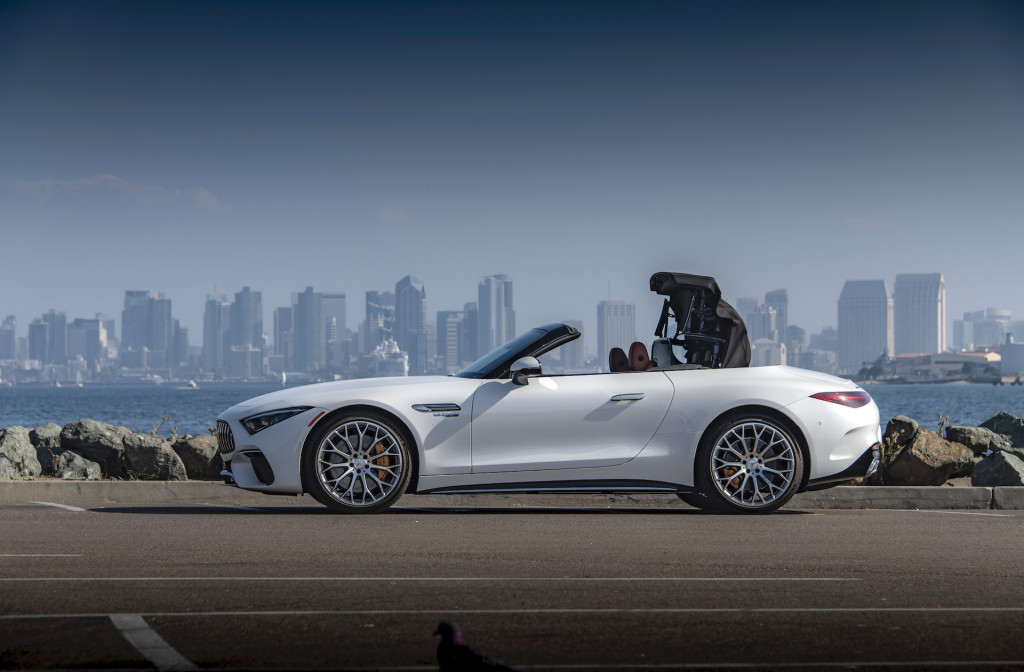
2022 Mercedes-Benz SL 55 AMG
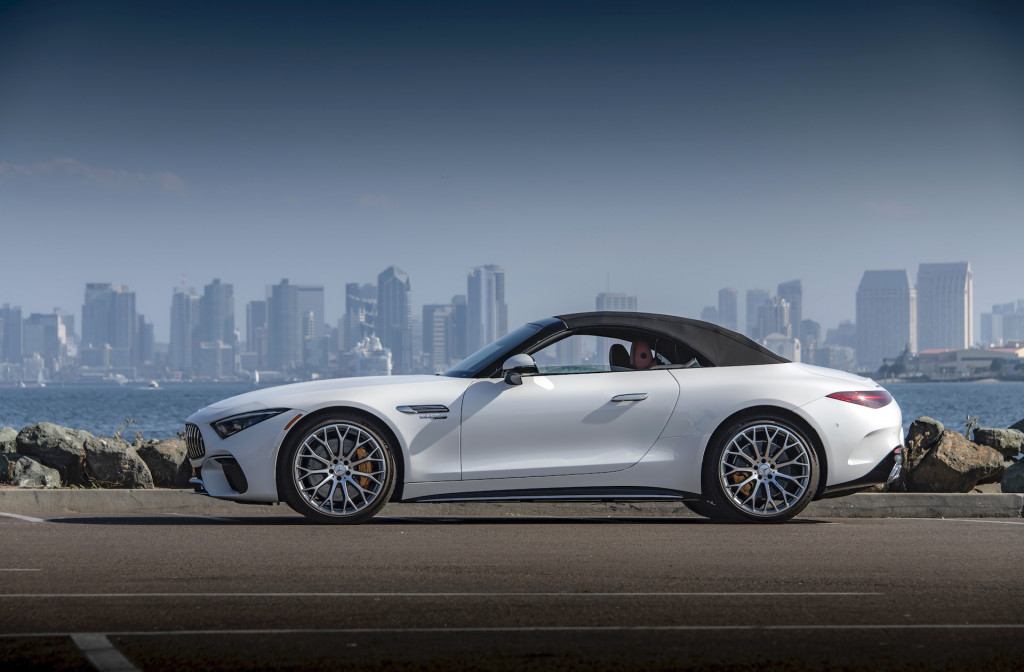
2022 Mercedes-Benz SL 55 AMG
Stiffer than the outgoing car with more advanced suspension technology and the ability to tune it for performance or comfort, the 2022 Mercedes SL is a more capable and better handling car than the fast but soft SLs of recent years.
The linked hydraulic dampers also work at the opposite end of the spectrum, loosening up during straight-line driving for a more comfortable ride. Active engine mounts, standard in the SL 63 and optional in the SL 55, do much the same: their magnetic fluid loosens up while cruising for a softer ride and firms up in corners to better prevent the engine from adding to the lateral inertia, resulting in quicker reactions. The new SL may perform better than the car it replaces, but it’s still smooth enough for comfortable use every day even with the optional 21s.
Inside, the SL boasts a lot more technology, too, though the interior still perfectly blends traditional SL themes of performance and luxury, while also giving a nod to the original 300SL with its minimalist look. A 12.3-inch digital screen serves as the instrument cluster and features a special visor to prevent reflections caused by sunlight, a must for driving with the top down. It offers several display themes—Understated, Classic, Sport, Supersport, and Track Pace—with layouts that range from so minimalist that only the immediate range of speed and torque are shown in the speedometer and tachometer to extensive on-board telemetry. Check out the information and designs, and choose the one that’s right for you. I’m partial to the look of Supersport and the dynamic information it shows.
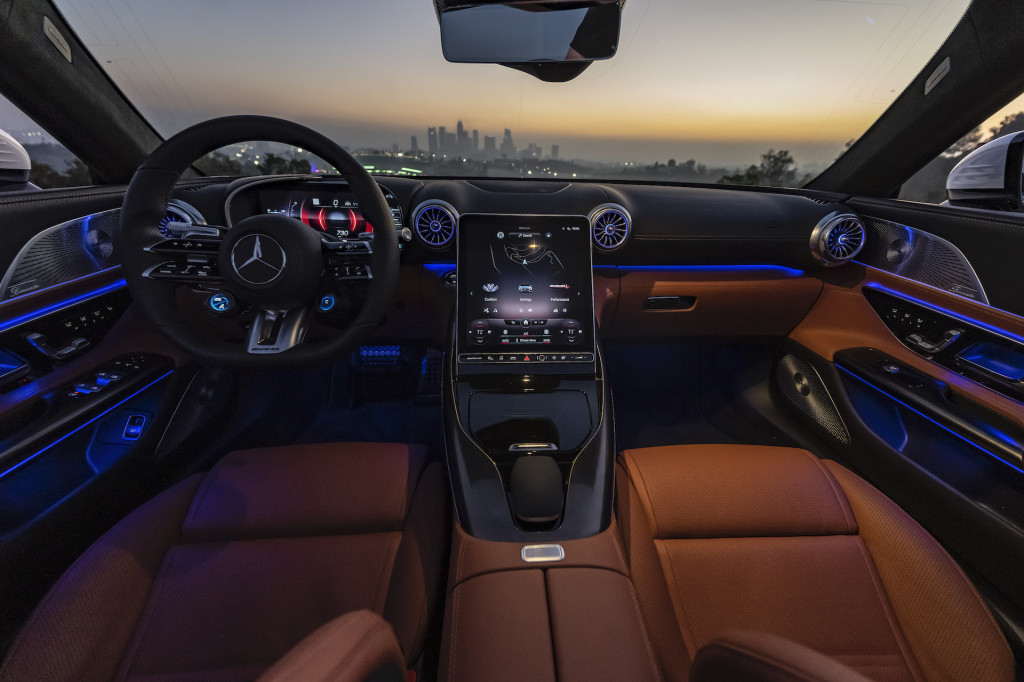
2022 Mercedes-Benz SL 55 AMG
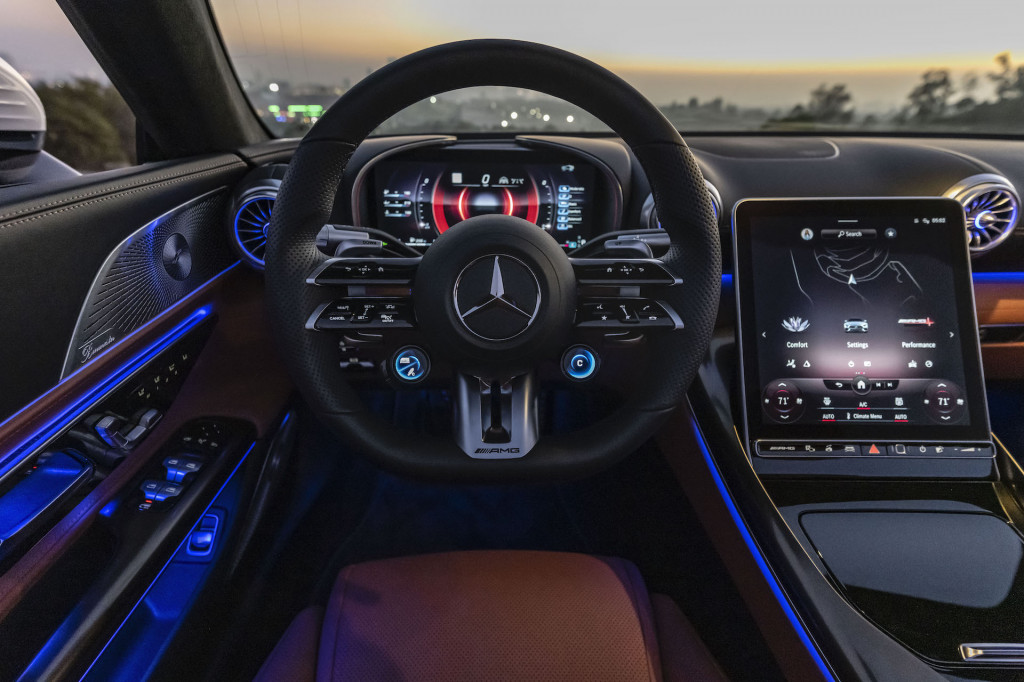
2022 Mercedes-Benz SL 55 AMG
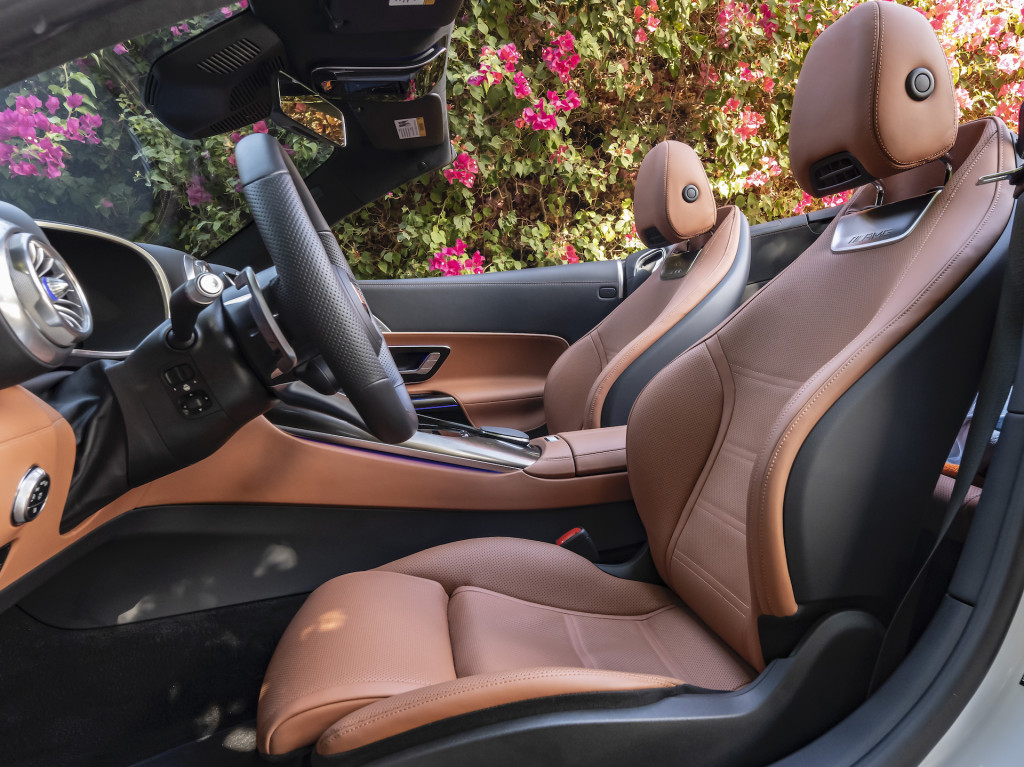
2022 Mercedes-Benz SL 55 AMG
An 11.9-inch portrait-style touchscreen sits in the center console as the main hub for infotainment. It tilts from a standard 32 degrees, which provides the most comfortable view to a far more upright 12 degrees to avoid reflections caused by sunlight. Under the screen are a row of physical buttons used to control frequently used items.
A head-up display is standard in the SL 63 and optional in the SL 55. It uses augmented reality to overlay arrows and for navigation directions.
It’s all easy to monitor sitting low in the coddling and supportive base sport seats or the even sportier optional seats. Either set of seats cradle bodies of just about any size quite well, and offer the additional pampering of heating, cooling, and massage.
I’m driving top up for most of this cold and rainy trip. The standard AirScarf neck-level heating can battle the cold but not block the rain. In the up position, the three-layer top blocks out most wind and road noise, though I detect some wind noise from the windshield header at highway speeds. The fully automated roof takes just 15 seconds to raise or lower, a process that can be done while traveling at speeds of up to 37 mph. Thank goodness it’s so quick because you have to swipe on the touchscreen to one side or the other to operate the top and keep your finger in place until the process is complete.
Mercedes loads up the SL with amenities such as soft nappa leather, Burmester audio, and a surround-view camera system, plus a full spate of standard and optional active safety features. Prices aren’t yet available, but we expect the SL to start around $100,000 when it hits the market this spring.
That’s about the same price as the outgoing car, but this time around buyers get a sharper, better performing grand tourer with additional utility and better technology. It doesn’t sport the exotic layout of the Porsche 911, but the new SL will appeal to buyers of the previous car, while also attracting more serious enthusiasts who want to carve through the canyons (preferably not in the rain) on the weekends.
Mercedes-Benz paid for travel and lodging for your author to bring rain to California and bring you this firsthand report.
